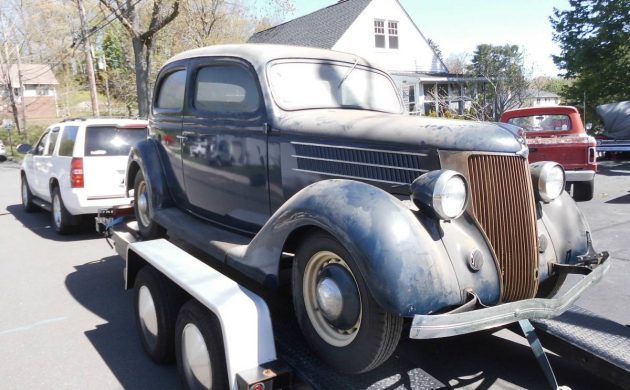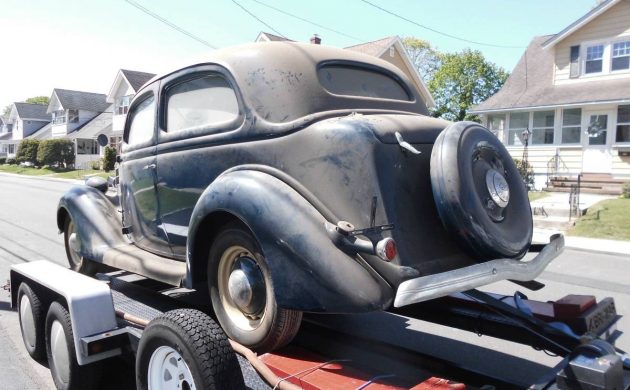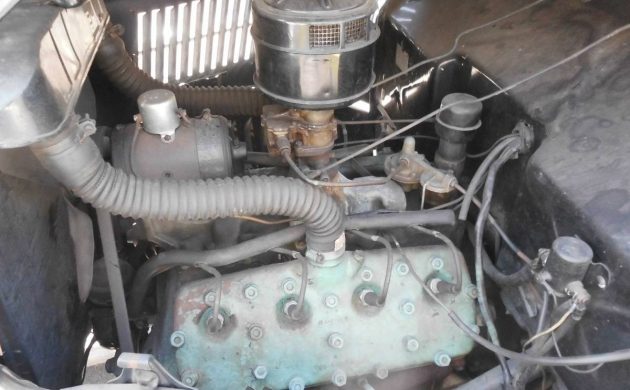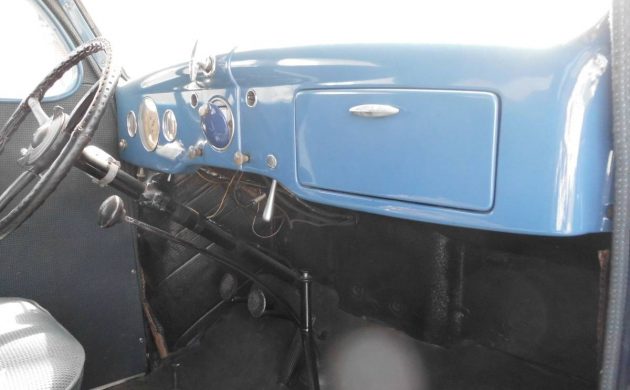With their redesign in 1935, Ford’s sedans were offered with a “trunkback” or “humpback” integrated trunk which provided more luggage capacity than before. But the more traditional “flatback” style was still offered. This level of styling would run across three years or through 1937. The seller’s 2-door coupe is one of the humpback sedans and recently emerged from the garage after being in hiding for 45 years. Some interior work has already been done, and more awaits the buyer on an overall solid automobile. Located in Branford, Connecticut, this Ford is available here on craigslist for $10,500. Another cool tip from T.J.
Technically known as the Model 48, the company’s main V8-powered cars were updated in 1935. The changes to the cars would resonate well with buyers who scooped up 820,000 units, more than the number Chevrolet sold that year. The autos were propelled by Ford’s 221 cubic inch flathead V8 that produced 65 hp. Two trim levels were offered, Standard and DeLuxe, and the cars were little changed going into 1936.
For reasons unknown, the seller’s 1936 Ford entered the garage in 1977 and stayed there for more than four decades. The odometer reading is 70,000, a lot of miles if the engine was never rebuilt. Besides the V8 motor (which does turn over), the car has a 3-speed manual transmission, a routine Ford fare. We don’t know what it would take to get this old girl running again, but they aren’t complicated mechanically to work on.
While there are loads of patina in the blue paint, the body is said to have zero rust, a plus for this 86-year-old-car. At some point, the interior has been redone in terms of upholstery, door panels, and dashboard which presents as new. While you could turn this car into a street rod, why not restore it to its original condition and be happy with a cool piece of automobilia?





Why not restore it to its original condition? Lets think about that, do you really want to drive an under powered Ford V-8 with a non synchronised transmisson, rear end gears so low, you can’t go over 55 mph and even if you could, the mechanical brakes would not stop you and the cooling system is so old and clogged up, it probably won’t cool. Driving it would maybe be for a parade or to the Ice Cream Store, if it wasn’t too far. You also could’t drive during rush hour or go on a free-way. You could of course do a mechanical reconditioning ,re-build the flathead , install a later transmission, put higher gears in rearend, new radiator, hydralic brakes maybe even disc’s up front. I am guessing it would be safe to drive and you could drive it most places anytime and your bank account would be down 10 grand or more depending on how you did it. Next choice go full speed ahead a full blown street rod re do a modern day resto mod, thats going to take the savings acoount down any where from 25 K to who knows 50 thousand or more. Then you really have something one of the most expensive 36 Fords on the planet. Your choice ,knock your lights out.
Cannot agree Joe. I had a ’37 club coupe as a daily driver with only the following upgrades : 41 Flathead (but still a flattie), ;40 hydraulics. Agree that the rear end is too high, probably 4.44/1, but this could be swapped out for a 3.78/ I cannot describe what an elixir driving a near stock ’30s or ’40s V8 Ford is. Wanna build a street rod? Buy a hot rod frame and replica body. Leave the original stuff alone. There’s too little of it left. What you describe is sacrilege.
Joe, you should probably educate yourself on this type engine and braking system. Many options are available to make this road worthy and still remain it’s stock condition. There are many options out there that can be built without modifying every stocker out there.
I wouldn’t change a thing,just check it over and drive it .Every car doesn’t have to turn a fast quarter mile or stop on a dime.I’ve been enjoying my 49 Ford for 30 plus years.It stops and shifts fine,tired flat head runs smooth.Lots of folks smile and wave and I like to drive it.It always has people looking at it at cruise night and it’s fun as it is:-)
Hear, hear, Harv!
I love driving my completely stock ’46 GMC 3/4-ton pickup around town. I even enjoy double-clutching and listening to the whine and whir of its straight-cut gears–who needs a “sound system” or even a radio? Sure, I wouldn’t venture onto the interstate with my truck. But I don’t need to. Hell, I’m old enough to remember how we found our way around before the damned things were built.
Old vehicles in their original incarnation are tantamount to time machines. They transport one back to a day when designers and engineers created vehicles that emphasized function over form, utility over excess, and simplicity over complexity. As for the kind of power that translates to impressive speed and acceleration, I’ve got that in my other cars. Indeed, everyone has it now, making such power a rather cheap commodity.
A 2 door sedan is NOT a “coupe”
Correct , Speedy – my Dad referred to this body type as a COACH
This is an exceptionally complete ’36. Somewhere along the trail the engine was converted to ’37 heads (and l water pumps) – there seems to a turn signal device hooked on the steering column as well, but no observable turn lights… Otherwise you have a very nice Standard (one wiper, one tail light) tudor. This is not a long-range cruiser any more, Joe Haska has it absolutely right, but this could be the greatest ever lightly restored (enuff to safely attend cars ‘n coffee in a 100-mile radius) car for most seasons. Tighten it up, polish it up and enjoy it for what it was – and still is. I’ve already had my share of ’36s, but this is a winner IMVHO.
My Dad restored a 36 5 window coupe back in the mid 80’s. Complete original resto. It drove just fine. Was great for going to shows, taking neighborhood kids for rides in the rumble seat and for a Sunday cruise. I could never imagine why one would want to take a car like this out onto modern freeways anyway.
BTW – He did the car in Ottawa Canada and sold it to someone in NY State. On the off chance anyone knows the location of that car I would love to know.
MyUncle had one during WWII, so worn out that the transmisson would lock up and couldn’t shift, had to take the top off and pry the loose
Richard and George,
Since you both commented on what I said, I feel obligated to reply. It is apparent that you both must know allot about Flathead Fords and are old enough to have driven them and worked on them and know about ,all the up grades available
Her is my experience, I am 79 years old and fell in love with Hot Rods in the mid-fifties before I was even old enough to have drivers licence. Note I didn’t say old enough to drive. I had 4 cars before,I got my 34 5-window in 1963. I still have it and drive it all the time. In that almost 60 years, I have had 3 Flat Heads in it and one SBF and one SBC Chevrolet. The best Flat Head was A Mercury block, 4″ Crank 286 ” backed by a 5 speed trans with OD. I could on an on about that and everything else, but my point if you want talk about all the mods for old Fords from brakes and steering and gears and rear ends just name it and I will fill you in. I may not have done them all, but if I haven’t I know someone who has. Here’s a list of most of the Ford cars, I have owned and driven for everyday transportation. 32 Ford Coupe, 34 Ford Coupe , 2 40 Ford Sedans, 3 -46 to 48 sedans and a Coupe, 51 Ford 2-door, 53 Ford 2-door, 5 -53 to 55 F-100 P/U’s. I know I am forgetting some ,but maybe you get my point. I have been in this old car thing for 60 years ,not only as an enthusiast but as a business. If you want to explain Early Fords ,Hot Rods, and especially Flat Head Fords and what its like to drive them and modify them, You might not want to assume, that some people might know as much about it as you two do.
JOE HASKA [email protected]
Motor is a 1937 21 stud. Water pumps in the block is diagnostic. 32-36 blocks have no place to mount water pumps in the block.
1936 model year was designated model 68, not 48 which is 1935 only. I spent many miles in my 1936 fordor touring sedan. Power was ample, brakes not so much. The three speed transmission received synchronizers in second and third in 1932.